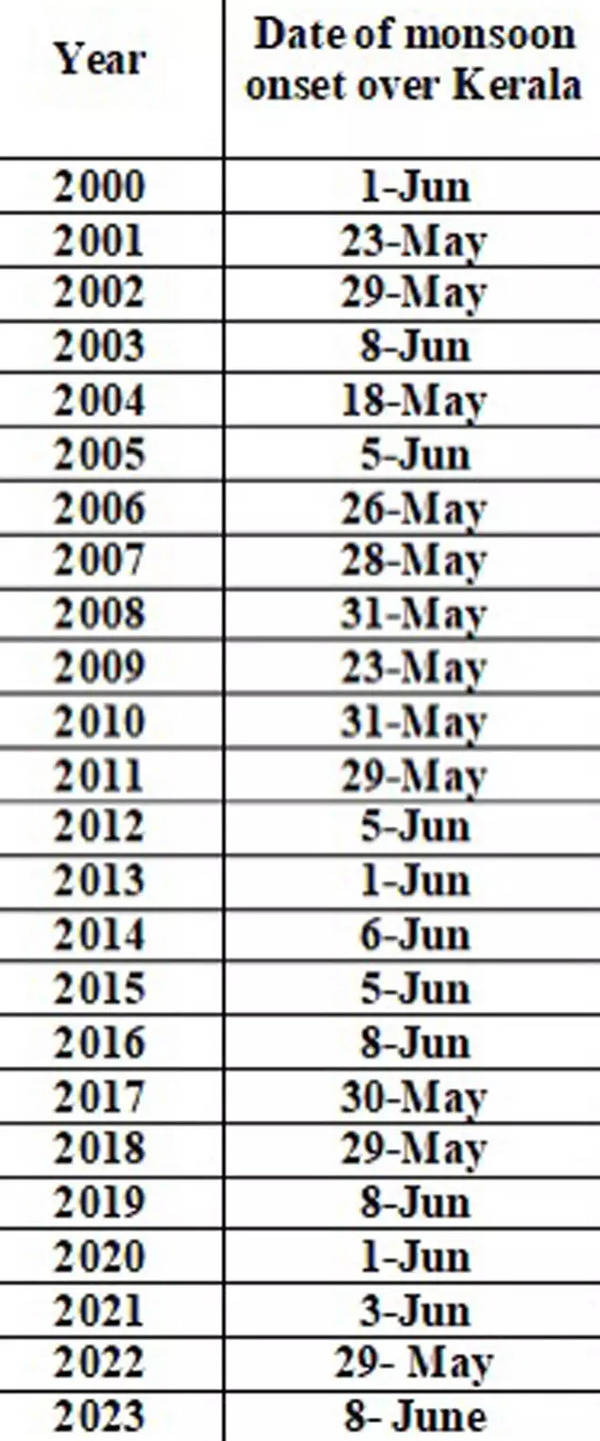[ad_1]
NEW DELHI: The southwest (summer) monsoon finally hit the Kerala coast on Thursday, marking the beginning of the rainy season in India. The onset is delayed by seven days against the normal date of June 1, similar to years 2016 and 2019 in the past decade when monsoon arrived as late as on June 8.
Delayed monsoon has, however, no correlation with quantitative and spatial distribution of rainfall as well as the pace of its progress over the remaining parts of India.
Announcing the onset of southwest monsoon over Kerala, the India Meteorological Department (IMD) on Thursday said the conditions are favourable for further advance of monsoon into some more parts of central Arabian Sea, remaining parts of Kerala, some more parts of Tamil Nadu, some parts of Karnataka and some parts of northeastern states during next 48 hours.
The Met department announced the monsoon’s onset after the rainfall and cloud formations met all the conditions including depth of westerly winds over Southeast Arabian sea. Besides, there has been widespread rainfall over Kerala during the past 24 hours — yet another condition to be considered for announcement of the onset.
Making its forecast, the IMD had on May 16 predicted the onset of monsoon over Kerala on June 4 with a model error of ± 4 days. So the arrival this year is within the forecast range. Summer monsoon normally sets in over Kerala on June 1 with a standard deviation of about 7 days even as it arrives over Andaman & Nicobar Islands around two weeks early.
The IMD has already predicted “normal” monsoon this year, despite evolving El Nino conditions (unusual warming of surface waters in eastern Pacific Ocean) that is generally linked to weak monsoon rains.
The past data shows that the years 2016 and and 2019 reported “normal” and “above normal” rainfall, respectively, despite making a delayed onset by seven days. Even distribution of rainfall was good in both these years, helping foodgrains’ output to reach the then record level of 275 million tonnes in 2016 and 297 million tonnes in 2019.
Banking on the forecast of “normal” monsoon this year, the agriculture ministry has set a target of 332 million tonnes of foodgrain output in 2023-24 crop year.
The IMD has been issuing operational forecasts for the onset date over Kerala since 2005. Records show that the Met department’s forecasts of the date of monsoon onset over Kerala during the past 18 years (2005-2022) were proved to be correct except in 2015. It has been using an indigenously developed state of the art statistical model with a model error of ± 4 days for the purpose of making a monsoon onset forecast.
Delayed monsoon has, however, no correlation with quantitative and spatial distribution of rainfall as well as the pace of its progress over the remaining parts of India.
Announcing the onset of southwest monsoon over Kerala, the India Meteorological Department (IMD) on Thursday said the conditions are favourable for further advance of monsoon into some more parts of central Arabian Sea, remaining parts of Kerala, some more parts of Tamil Nadu, some parts of Karnataka and some parts of northeastern states during next 48 hours.
The Met department announced the monsoon’s onset after the rainfall and cloud formations met all the conditions including depth of westerly winds over Southeast Arabian sea. Besides, there has been widespread rainfall over Kerala during the past 24 hours — yet another condition to be considered for announcement of the onset.
Making its forecast, the IMD had on May 16 predicted the onset of monsoon over Kerala on June 4 with a model error of ± 4 days. So the arrival this year is within the forecast range. Summer monsoon normally sets in over Kerala on June 1 with a standard deviation of about 7 days even as it arrives over Andaman & Nicobar Islands around two weeks early.
The IMD has already predicted “normal” monsoon this year, despite evolving El Nino conditions (unusual warming of surface waters in eastern Pacific Ocean) that is generally linked to weak monsoon rains.
The past data shows that the years 2016 and and 2019 reported “normal” and “above normal” rainfall, respectively, despite making a delayed onset by seven days. Even distribution of rainfall was good in both these years, helping foodgrains’ output to reach the then record level of 275 million tonnes in 2016 and 297 million tonnes in 2019.
Banking on the forecast of “normal” monsoon this year, the agriculture ministry has set a target of 332 million tonnes of foodgrain output in 2023-24 crop year.
The IMD has been issuing operational forecasts for the onset date over Kerala since 2005. Records show that the Met department’s forecasts of the date of monsoon onset over Kerala during the past 18 years (2005-2022) were proved to be correct except in 2015. It has been using an indigenously developed state of the art statistical model with a model error of ± 4 days for the purpose of making a monsoon onset forecast.

Source: IMD
[ad_2]
Source link




